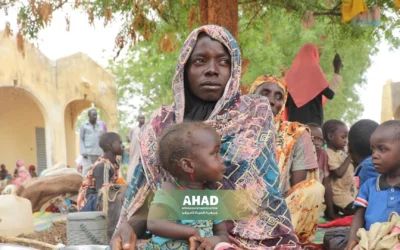Solutions to famine in Africa
The roots of the famine problem in Africa and the importance of sustainable solutions
Famine in Africa is a chronic and complex problem with deep and multiple roots, in which historical, economic, environmental, and social factors overlap. This crisis does not stem solely from food shortages, but is the result of a complex interaction of multiple factors that have led to the deterioration of economic, social and environmental conditions in many African countries.
Historical factors
The history of European colonization in Africa has a long-lasting impact on the economic and political structures of the continent. The colonists reshaped local economies to meet their needs, destroying traditional farming systems and forcing communities to rely on growing cash crops instead of food crops. This colonial legacy has left many African countries with fragile economies and heavily dependent on the export of raw materials, increasing their exposure to the volatility of world markets.
Economic factors
High poverty rates in Africa are one of the main factors contributing to the persistence of famine. Many Africans live below the poverty line, leaving them unable to buy or produce enough food to meet their daily needs. In addition, many African countries rely on foreign food aid to meet their needs. While this assistance provides a temporary solution, it may create a situation of dependence and long-term unsustainability, preventing the development of sustainable local solutions for food security.
Environmental factors
Climate changes are significantly affecting agriculture in Africa, where the frequency and severity of droughts and floods are increasing. Such conditions lead to a decrease in the productivity of agricultural crops and the destruction of Natural Resources, which increases the risk of famine. Desertification and land degradation also lead to a decrease in soil fertility and a reduction in arable areas, which limits the ability to produce food and increases the dependence of the population on food aid.
Social and political factors
Corruption and mismanagement in some African countries are diverting resources away from vital sectors such as agriculture, health and education. As a result, support and resources are not being effectively directed to improving food security. In addition, many African countries are experiencing rapid population growth, which increases the pressure on food resources and infrastructure. Without improvements in agricultural and economic production, it is difficult to meet the needs of a growing population.

The importance of sustainable and comprehensive solutions
To effectively address the famine crisis in Africa, sustainable and comprehensive solutions must be adopted that address the root causes of the problem and strengthen the resilience and self-sufficiency of communities. Sustainable solutions require coordination between local governments, international organizations, and local communities to ensure sustainable agricultural development and a better food future for the continent. These solutions should focus on improving agricultural technologies, investing in infrastructure, enhancing governance and transparency, and increasing awareness and training on sustainable agricultural practices. Through these integrated efforts, African countries can achieve lasting improvements in food security and famine reduction, enhancing the ability of communities to be self-sufficient and build a bright and sustainable future.
Comprehensive solutions to combat famine in Africa: strengthening agriculture, infrastructure, governance and education
Africa faces significant challenges in the fight against famine, as economic, environmental, and social factors overlap to make it difficult to achieve food security. To strengthen the capacities of local communities and ensure sustainable food supply, a comprehensive approach should be taken that includes promoting sustainable agriculture, investing in infrastructure, improving governance, and raising awareness and education. In this article, we review the most important proposed solutions to meet these challenges.
Promoting sustainable agriculture
Agriculture is the backbone of the economies of many African countries, so promoting sustainable agriculture is an essential step to eradicate famine.
Improvement of agricultural technologies
– Technologies such as drip irrigation, vertical farming and organic farming can increase the efficiency of agricultural production and reduce waste. These technologies help to use water more effectively, reduce dependence on harmful chemicals, and enhance productivity in small spaces.
– Promote research and development in the fields of crop improvement and the development of new technologies to combat pests and climate changes. Supporting agricultural research centers and developing new technologies can contribute to increasing yields and improving their resistance to diseases and drought.

Soil and water conservation
-Through practices such as crop rotation and conservation agriculture, soil fertility can be maintained and productivity increased. Crop rotation helps reduce the spread of pests and diseases, while conservation agriculture contributes to improving soil structure and increasing its water-retaining capacity.
– The development of rainwater harvesting systems and effective irrigation can help to counteract water scarcity in dry areas. The use of technologies such as rainwater collection tanks and drip irrigation can increase the amount of water available for agriculture.
Encouraging the cultivation of diverse and drought-resistant crops
– The cultivation of diverse crops, including local crops that are more resistant to drought and pests, can enhance food diversity and reduce the risk of agricultural failure. Crop diversification helps ensure year-round food availability and reduces dependence on a single crop that may be vulnerable to natural disasters.
Investment in infrastructure
Efficient infrastructure is a critical factor in improving food distribution and reducing waste.
– Improved transport infrastructure ensures that agricultural products from farmers reach markets quickly and efficiently, reducing food waste. Good roads and bridges facilitate the movement of food products and help reduce the cost and time spent on transportation.
– Providing efficient means of transportation connecting rural areas with the main markets enhances the marketing of agricultural products and increases income for farmers. Improving transportation contributes to reducing waste and improving the quality of food available to consumers.
– The establishment of refrigerated storage facilities and insect-resistant facilities can help reduce crop losses after harvest. Good storage ensures the preservation of food quality and reduces waste due to spoilage.
– Applying modern inventory management techniques that ensure the preservation of food quality for longer periods. Effective management systems help organize the flow of food products and distribute them appropriately according to needs.
– The use of solar-based irrigation systems and smart irrigation technologies can increase the efficiency of water use. These systems allow farmers to control the amount of water used and accurately direct it to the areas that need it.
– Encouraging the use of solar and wind energy in the operation of water pumps and irrigation systems enhances agricultural productivity and reduces operating costs. Dependence on renewable energy contributes to the sustainability of agricultural enterprises and reduces the negative environmental impact.
Improving governance
Improving governance and combating corruption are key to enhancing the effectiveness of anti-famine efforts.
– Promoting transparency and applying strict anti-corruption laws that ensure the efficient use of resources to achieve agricultural development. Anti-corruption laws contribute to properly directing support and resources to the sectors most in need.
– The establishment of independent supervisory bodies to monitor the distribution of aid and ensure its access to the beneficiaries. These bodies contribute to strengthening trust between donors and beneficiaries and ensure the achievement of the desired goals.
– Improved systems for collecting and analyzing data on agricultural production and food distribution can help in making informed decisions. Accurate information systems allow stakeholders to track food gaps and prioritize interventions.
– Enhancing transparency by sharing information with local communities and NGOs ensures better cooperation and effective results. Information sharing increases awareness and enhances community participation in achieving food security.
Education and outreach
Raising awareness about proper nutrition and sustainable agricultural practices can help local communities achieve food security more effectively.
– Implement educational programs in schools and communities to sensitize people to the importance of food diversity and proper nutrition. These programs contribute to improving the nutritional and healthy habits of the population.
– Organizing awareness campaigns to raise awareness of the importance of healthy food and how to prepare it in sustainable ways. Awareness campaigns help change eating behaviors for the better and enhance food security.
A
Ahad’s efforts to promote sustainable development in central and West Africa
AHAD works hard in the heart of the African continent, focusing its efforts especially in the countries of Central and West Africa with the aim of improving the quality of life of the poor and disadvantaged in those regions. The organization’s projects cover vital areas including health, education, water, and economic development. Through these efforts, AHAD seeks to make a positive and sustainable impact in the lives of the communities it serves, adhering to its motto “because it deserves life”.
AHAD community development strategy
AHAD understands the unique nature of the communities she works with, which has led her to choose strategies that leverage the skills and abilities of local individuals. These strategies are based on enhancing community participation and empowering local people to have an effective role in building their communities and achieving sustainable development. The organization aims to provide basic needs such as clean water and healthcare, improve the quality of education, and enable individuals to actively participate in building productive and sustainable communities.
The main areas of work of the AHAD Association
– AHAD is working to improve health services in remote areas by building clinics, providing medicines and health awareness.
– Carry out campaigns to prevent common diseases such as malaria and HIV (AIDS) through the distribution of mosquito nets and periodic testing.
– AHAD is building new schools and renovating old schools to provide a suitable learning environment.
– Provides training courses for teachers to improve teaching methods and ensure the quality of education provided to children.
– The organization works to drill wells and provide clean water sources to communities suffering from water scarcity.
– Awareness campaigns are organized to teach people how to keep water clean and use it optimally.
You can visit the AHAD website to find out more about the projects it offers
ALSO READ
WHAT THE FOOD BASKET CONTAINS IN AHAD
Join us in our message




